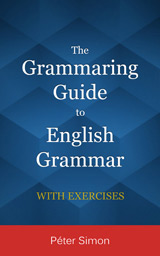Appendix: spelling rules
Present simple -S
The present simple form of the verb is identical to the base form in all persons except the third person singular. The third person singular is formed by adding -s to the base form:
work » works
live » lives
stay » stays
try » tries (a final -y changes to -ie- after a consonant)
wash » washes; kiss » kisses; watch » watches; box » boxes (we add -es after -sh, -s, -ch and -x)
go » goes (we add -es)
do » does (we add -es)
have » has
Past simple -ED
In the case of regular verbs, the past simple is formed by adding -ed to the base form of the verb for all persons:
look » looked
stay » stayed
arrive » arrived (we only add -d if the verb ends in -e)
try » tried (a final -y changes to -i- after a consonant)
stop » stopped (we double the final consonant if the verb ends in consonant-vowel-consonant)
-ING (simple gerund and present participle)
The simple gerund and the present participle are formed by adding -ing to the base form of the verb:
read » reading
study » studying
grow » growing
relax » relaxing
answer » answering
write » writing; argue » arguing (a final -e is omitted)
agree » agreeing (a final -ee does not change)
lie » lying (a final -ie changes to -y-)
put » putting; regret » regretting; readmit » readmitting (we double the final consonant if the verb ends in consonant-vowel-consonant, with the exception of w, x and y, and only has one syllable or has the stress on the last syllable)

